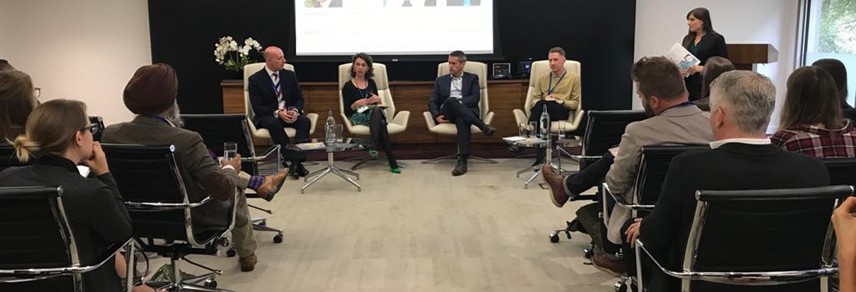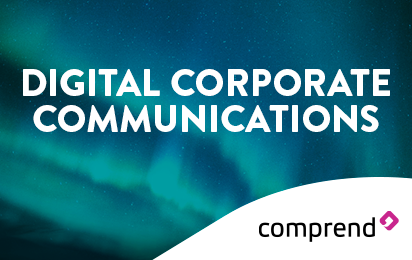
CORPORATE CONTENT UNDER THE MICROSCOPE AT CORPORATE CONTENT CONFERENCE
The Corporate Content Conference gave insight into the use of corporate content, while capturing the audience’s attention through captivating panels of established communications professionals and pioneering case studies.
Kicking off the conference was a panel consisting of Des Good, managing director at Grosvenor Film, and Duncan Shaw, co-founder and executive creative director of branding agency Living Group, the discussion revolved around the role of film in corporate content. Having become one of the most impactful platforms for corporate communications, film was analysed in regard to its offering, the strategy behind it, the use for it in social media, as well as the challenges it presents.
“If you have a straight line of what you want to do, the decision making is a simple, straightforward process,” Shaw said.
When working with a corporate organisation, however, the gap between the creative drive and the desires of the organisation can often have a negative result on the final product. Good said, “It requires quite a bit of negotiation to achieve what you want.”
The biggest challenge with video is the risk of seeming insincere and over-rehearsed. A good way to avoid that is to “never ask anybody to do something they don’t know how to do,” Good said. “If you’re not telling the truth, people see straight through it.”
For the second session, the conference focused on a case study from the NHS’s Blood and Transplant creative agency Aesop. The case study was presented by Aesop’s executive creative director, Ben Cooper, and founding partner and director of narrative, Ed Woodcock. With the task of educating people about organ donations and driving transplant and blood donations, the duo came up with a Valentine’s Day campaign called ‘Yes I do(nate).’
Cooper explained that it is important to know when, where and how it is right to tell a story. “For this particular project, social media was a good choice, because social media is extra busy on Valentine’s day, but it also needed to be both entertaining and informative,” Cooper said.
A topic of great interest was that of transaction and creative translation in transferable branding, where Melanie Chevalier, founder and CEO of marketing and advertising agency Creative Culture, and Meher Mumtaz, global brand director of Western Union, talked about the implementation of brand language, tone of voice and visual identity for international audiences. “Audiences today are global citizens, they often have associations with different global markets, so, companies need to switch their strategy and offering to address that,” Mumtaz said.
The session concluded with some transcreation and storytelling tips that included the importance of cross-cultural assessment during the conceptualisation phase and the need to convey a message and not just translate words, among others.
A riveting panel on tone of voice followed consisting of David Boardman, director of communications and engagement at civil service pensions company MyCSP, Rachel Cooper, director of global content strategy and editorial at GSK, Bob Morris, managing partner of Instinctif Partners and Jack Preston, senior content lead of Virgin Group. The panel delved into a productive conversation about setting the right tone in corporate content and communications, as well as achieving consistency through it.
Talking about the decision making behind setting the right tone, Cooper said, “We have to be guided by the audience we’re speaking to and the channel we are using. We also need to have a human voice, to make us feel relatable.”
Morris added, “It’s crucial to understand the risk,” highlighting how easy it is for the tone of voice to negatively affect a company, when inappropriate.
Differentiating a brand from the industry using the right tone of voice, is no easy task. In this scenario, the content of the messaging is more important than the way it will be delivered. According to Cooper, “It comes down to what you’re saying and the way you say it.”
Boardman stressed the importance of analytics as palpable evidence that can be shown to the client to prove a project’s success. “Analytics are key, because they give me the ability to go back to my client and show specific evidence to prove my point,” Boardman said, encouraging everyone to “get behind the figures!”
Following the panel, another case study was presented by Lucy Harley, director of creative content at digital communications agency Investis, for the work Investis did for Asos, trying to go beyond ‘traditional’ investor content to meet audience and business needs. The project focused on the content, the visual language, the messaging and tone of voice, the functionality and the structure. Furthermore, Hartley mentioned that Investis focus on its strategy and outlook, to meet the needs of content explorers and information hunters.
The conference’s final session was on print, digital and multichannel publications, with a panel consisting of Emily Kirawn, head of internal communications and engagement at BBC News, Susan McKenzie, editor of account firm Deloitte, and Tim Rutter, head of internal communications and community liaison at steelmaking company Tata Steel UK. The speakers explored the challenges, creative opportunities and communications impact involved in developing a corporate publication.
“Our greatest worry is not the format, but consistency, while trying to write something that everyone understands no matter their age or background,” McKenzie continued, while Rutter added, “It’s about understanding the lives of the people we address.”
Kirwan added, “BBC, for example, is so diverse, that in terms of format, the key is telling the story in lots of different ways, across different channels.”
The panels were familiar with writing on behalf of a corporate leader. It’s something almost every content creator in a corporate environment does, and the task is riskier than people realise. Offering his advice, Rutter said, “Trust and understand the individual and note their phraseology, because leaders nowadays are approachable, and people know what they sound like.” Kirwan echoed that, “It needs to be a relationship of trust. You need to know what they care or don’t care about, otherwise the content will be disingenuous.”
The conference was held at communications consultancy Instinctif Partners’ London offices. This year’s Corporate Content Awards are currently open for entry. To submit your work click here.
For more from Communicate magazine, follow us on Twitter @Communicatemag


